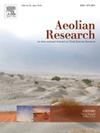Dust transport pathways from The Great Basin
IF 3.4
3区 地球科学
Q2 GEOGRAPHY, PHYSICAL
引用次数: 0
Abstract
The Great Basin is at risk of increased wind erosion and dust emissions due to grazing pressure, urbanization, wildfire, and non-native plant invasion. Recent efforts to quantify wind erosion risk on Great Basin rangelands identified high to extreme wind erosion and dust emission hotspots. However, the spatial extent and seasonal variability of dust transport pathways from the Great Basin, and thus the local and regional dust impacts, are not well understood. Here, we computed forward air-parcel trajectories using the Hybrid Single-Particle Lagrangian Integrated Trajectory model using the North American Regional Reanalysis 32-km meteorological data and kernel density analysis to describe potential seasonal dust transport pathways associated with three Great Basin wind erosion hotspots. Probability mass-densities for six different heights above ground level (AGL) were estimated to describe the spatial and vertical extent of potential dust transport across North America. A large proportion of trajectories occurred within 0 – 500 m AGL in spring (25.9 % − 32.7 %), fall (33.6 % − 35.1 %), and winter (44.1 % − 53.8 %). The proportion of trajectories at 2000 – 5000 m AGL is highest in summer (32.1 % − 39.8 %) and spring (23.0 % − 23.3 %). Thus, long range west-to-east transport of dust over North America is likeliest in summer. However, local redistribution of dust near hotspots, is more likely in spring, fall, and winter. This study helps to link potential dust transport pathways to wind erosion hotspots for mitigating the local and regional impacts of dust emissions, informing rangeland management strategies, and improving air quality assessments across North America.
来自大盆地的尘埃运输路径
由于放牧压力、城市化、野火和非本地植物入侵,大盆地面临着风蚀和粉尘排放增加的风险。最近对大盆地牧场的风蚀风险进行量化的工作确定了风蚀和沙尘排放的高危和极端热点地区。然而,人们对来自大盆地的沙尘传输路径的空间范围和季节性变化,以及对当地和区域沙尘的影响还不甚了解。在此,我们使用混合单粒子拉格朗日综合轨迹模型,利用北美区域再分析 32 公里气象数据和核密度分析,计算了前向空气包裹轨迹,以描述与大盆地三个风蚀热点相关的潜在季节性沙尘传输路径。估算了离地面(AGL)六种不同高度的概率质量密度,以描述北美潜在沙尘传输的空间和垂直范围。在春季(25.9% - 32.7%)、秋季(33.6% - 35.1%)和冬季(44.1% - 53.8%),大部分轨迹发生在 0 - 500 m AGL 范围内。在 2000 - 5000 米 AGL 高度的飞行轨迹比例在夏季(32.1 % - 39.8 %)和春季(23.0 % - 23.3 %)最高。因此,北美上空由西向东的尘埃长程飘移最可能发生在夏季。不过,在春季、秋季和冬季,热点地区附近的沙尘更有可能发生局部再分布。这项研究有助于将潜在的沙尘传输路径与风蚀热点联系起来,以减轻沙尘排放对当地和区域的影响,为牧场管理战略提供信息,并改善整个北美地区的空气质量评估。
本文章由计算机程序翻译,如有差异,请以英文原文为准。
求助全文
约1分钟内获得全文
求助全文
来源期刊

Aeolian Research
GEOGRAPHY, PHYSICAL-
CiteScore
7.10
自引率
6.10%
发文量
43
审稿时长
>12 weeks
期刊介绍:
The scope of Aeolian Research includes the following topics:
• Fundamental Aeolian processes, including sand and dust entrainment, transport and deposition of sediment
• Modeling and field studies of Aeolian processes
• Instrumentation/measurement in the field and lab
• Practical applications including environmental impacts and erosion control
• Aeolian landforms, geomorphology and paleoenvironments
• Dust-atmosphere/cloud interactions.
 求助内容:
求助内容: 应助结果提醒方式:
应助结果提醒方式:


